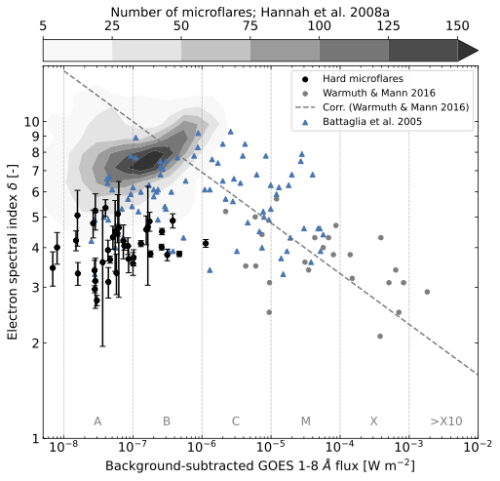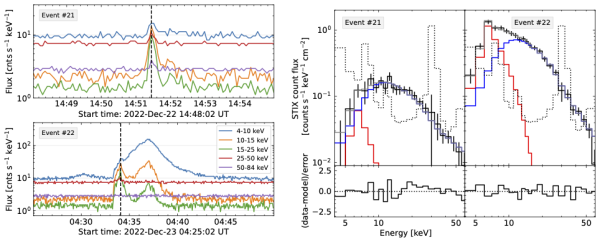All microflares that accelerate electrons to high energies are rooted in sunspots
| Nugget | |
|---|---|
| Number: | 471 |
| 1st Author: | Andrea Francesco BATTAGLIA |
| 2nd Author: | |
| Published: | September 30, 2024 |
| Next Nugget: | X9.9! |
| Previous Nugget: | The warm-target model and kappa distributions |
Introduction
Generally, major solar flares are more efficient at accelerating high-energy electrons than microflares (Ref. [1]). Nonetheless, we sometimes observe microflares that also accelerate electrons to high energies, as shown in Figure 1. Their origin has been unclear, but the sample selection is well-defined.

From observations taken by STIX, the Spectrometer/Telescope for Imaging X-rays, the X-ray telescope on board the Solar Orbiter mission. Our study (Ref. [2) focuses on statistically analyzing 39 microflares (of GOES A and B class, after pre-flare subtraction) with strikingly hard spectra in the hard X-ray range (power-law indices ranging from 2 to 5), which means that they are efficient in accelerating high-energy electrons. We refer to these events as "hard microflares." In our study, these events have been observed between January 2021 and May 2023.
Footpoint location of hard microflares
Figure 2 shows time profiles and spectra for two hard microflares. We note strikingly different behaviour of these events with respect to standard microflares: short (20 s) high-energy (> 30 keV) bursts with limited thermal response. The corresponding spectral fit, modelled with a standard isothermal model at low energies and a thick-target model at higher energies, results in a relatively flat spectrum at high energies. This is a clear signature for the efficiency of the acceleration mechanism in these events for accelerating electrons to high energies.

In Figure 3, we compare the locations of different types of microflares that occurred in NOAA active region 12882. The two hard microflares (left [anels) each have one footpoint directly rooted in sunspots, as shown by the AIA 1600 Å contours in red. This property had been noted alread in Ref. [5]. By contrast, two "standard" microflares are located away from the sunspots, such as in the plage regions surrounding the active region (right panels, blue contours). The novelty here is that all 39 hard microflares in our statistical study are rooted in sunspots, either directly in the umbra or in the penumbra.

Discoveries
This statistical study has given us additional interesting information. First of all, for the events with the classic two-footpoints morphology, the absolute value of the mean line-of-sight magnetic field density at the footpoint rooted within the sunspot (obtained with SDO/HMI magnetograms) ranges from 600 to 1800 G, whereas the outer footpoint measures from 10 to 200 G. This means that the magnetic flux density at the footpoint directly rooted within the sunspot can be about 10 times stronger than the outer footpoint. In addition, despite the large difference of the magnetic field at the flare footpoints, approximately 78% of hard microflares, which exhibited two HXR footpoints, have similar or even stronger HXR flux from the footpoint rooted within the sunspot (right panel of Fig. 4). Assuming a simple magnetic loop with similar densities on both sides, this is inconsistent with the magnetic mirroring scenario (e.g., Ref. [6], p. 30) and an acceleration mechanism above the loop-top, as the HXR flux from the footpoint in the sunspot should be lower. This suggests the need for major revisions of the standard model: the assumption of similar densities on both sides of the loop may be inaccurate, the flare-accelerated electrons might have a beamed distribution, somehow inhibiting mirroring effects, or the energy release site may be located close to the sunspot and perhaps not in the corona at all.
Conclusions
We conclude that all hard microflares are rooted in sunspots, which implies that the magnetic field strength plays a key role in efficiently accelerating high-energy electrons, with hard spectra associated with strong fields. This key result deepens our understanding of the mechanisms for electron acceleration and magnetic energy release in flares and space plasmas.
References
[3] "RHESSI Microflare Statistics. II. X-Ray Imaging, Spectroscopy, and Energy Distributions"
[4] "Size dependence of solar X-ray flare properties"
[5] "Efficiency of solar microflares in accelerating electrons when rooted in a sunspot"